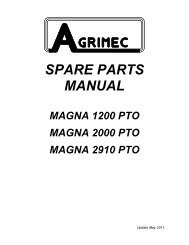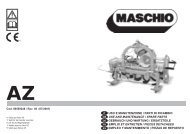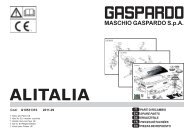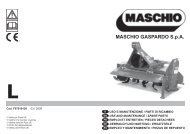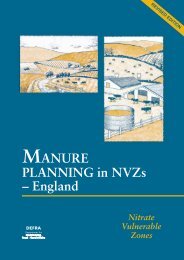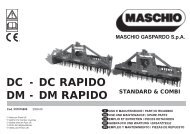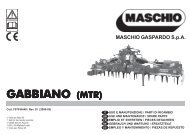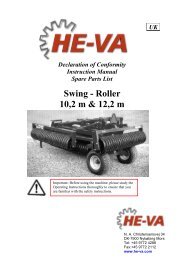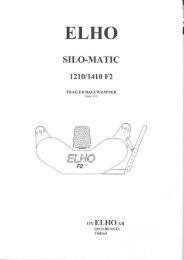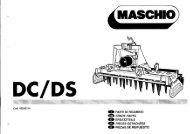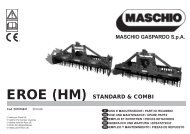GRAIN DRYER & PARTS BOOK - Opico
GRAIN DRYER & PARTS BOOK - Opico
GRAIN DRYER & PARTS BOOK - Opico
You also want an ePaper? Increase the reach of your titles
YUMPU automatically turns print PDFs into web optimized ePapers that Google loves.
desired value is reached. One depression will raise or lower - depending on which key is used - the setpoint one<br />
degree. If either key is depressed and held, the temperatures will increment or decrement at the rate of once<br />
per second until the key is released or a limiting value is reached.<br />
The library also contains values above which the grain may not be set. Attempting to raise the grain<br />
temperature above the plenum setpoint is also not allowed. The grain temperature may not be set to freezing or<br />
below.<br />
If the grain type was unchanged, then the initial grain setpoint will be whatever it was set to previously.<br />
If the grain selection was changed, the initial value will be the one stored in the library.<br />
Changing the grain setpoint has no effect on any other setting. It may be changed before drying commences<br />
or after it has begun.<br />
This sub-menu may only be left by answering with a YES response, establishing the last displayed value<br />
as the setpoint.<br />
Select the Cool-Down Temperature - Pressing the YES key will cause the display to change to:<br />
Cool? ttt sdddS<br />
The Cool? portion of the message indicates that the user can adjust the temperature the grain must reach<br />
before unloading will commence. The ttt sdddS format is similar to the two previously introduced. ttt is the<br />
grain temperature which will initiate an unload. sddd is the sign and the difference between ttt and the grain<br />
setpoint temperature. S is the temperature system and will be an F for Fahrenheit and a C for Celsius.<br />
NOTE: Care must be exercised in setting the cool temperature. If it is set above the grain temperature setpoint,<br />
unloading will never occur. This will also happen if the cool down temperature is set below the ambient temperature.<br />
If the grain setpoint displayed is not the one desired, use the (UP) and (DOWN keys until the desired<br />
value is reached. One depression will raise or lower - depending on which key is used - the setpoint one<br />
degree. If either key is depressed and held, the temperatures will increment or decrement at the rate of once<br />
per second until the key is released.<br />
If the grain type was unchanged, then the initial cool setpoint will be whatever it was set to previously. If<br />
the grain selection was changed, the initial value will be the one stored in the library.<br />
Changing the cool setpoint has no effect on any other setting. It may be changed before drying commences<br />
or after it has begun.<br />
After the cool temperature has been set, the YES key must be depressed and released. This will cause the<br />
controller to return to the state it was in before the grain drying parameter subprogram was entered at the beginning.<br />
The display will once again shows Set Drying Data?. Depress and release the NO key to move to the drying<br />
mode options. If it is desired to return to the grain parameter setting sub-menu, perhaps to change a previously<br />
accepted value, press the YES key.<br />
Drying Mode Options - Once the grain drying parameters are set, the operator is provided with several<br />
options to initiate the drying process. Figure 4D (page 27) shows the options which are available.<br />
Four Initial Choices - Although Figure 4D shows three apparent options, the first contains two closely<br />
associated choices, making a total of four. These appear in the following order: automatic continuous batch drying,<br />
single batch drying, grain bin fill and grain bin unload.<br />
26



